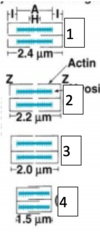2014 Module Exam Flashcards
(127 cards)
a patient being treated for Heart failure comes with an enlarged swollen breast what is the cause of this side effect?
A) digoxin
B) angiotensin receptor blocker
C) aldosterone blocker
D) beta blocker
E) angiotensin converting enzyme inhibitor
C) aldosterone blocker
(Spironolactone is known to cause more gynecomastia or breast pain)
What is the condition that increases with age?
A) Ventricular fibrillation
B) Atrial fibrillation
C) Sinus bradycardia
D) Sinus tachycardia
B) Atrial fibrillation
what corresponds to the S1 sound?
A) it indicates the aortic valve closure
B) The physiological split of S1 is usually heard
C) It can be heard in the apical part of the heart
D) It indicates the pulmonary valve closure
E) it can be heard in the 2nd right intercostal space
C) It can be heard in the apical part of the heart
aortic valve opens when the interventricular pressure is 90 mmHg the stroke volume was 70 mL. If the aortic compliance is 1 ml/mmHg and 50% of the stroke volume was stored in the aorta what is the systolic blood pressure?
A) 125
B) 150
C) 143
A) 125
Which structure of streptococcus pyogens mimic the heart antigens in the host?
A) flagella
B) M protein
C) polysaccharide capsule
B) M protein
a person with resting cardiac output 5.04 L/min if the EDV=150 ml and ESV=50 ml. what is his Heart rate?
A)50
B)100
C)25
A)50
In the of Endothelial dysfunction in coronary artery which of the following abnormalities can occur?
A) increased diastolic Reactive hyperemia
B) Inhibited platelet aggregation
C) Decreased coronary vascular tone
D) Acetylcholine mediated coronary spasm
D) Acetylcholine mediated coronary spasm
What passes along the inferior border of the heart?
A) right marginal
B) left marginal
C) nodal artery
D) posterior descending artery
E) left anterior descending
F) diagonal
G) left coronary artery
H) circumflex artery
A) right marginal
Is a direct branch of the left anterior descending artery.
A) right marginal
B) left marginal
C) nodal artery
D) posterior descending artery
E) left anterior descending
F) diagonal
G) left coronary artery
H) circumflex artery
F) diagonal
Which of the following is commonly present in physically fit individuals?
A) sinus tachycardia
B) atrial flutter
C) atrial fibrillation
D) Ventricular fibrillation
E) Sinus bradycardia
E) Sinus bradycardia
Pathophysiology of Atrial Fibrillation
A) Atrioventricular accessory pathway
B) AV node reentry
C) Micro reentry
D) Early afterdepolarization
E) Late afterdepolarization
C) Micro reentry
Pathophysiology of Supraventricular Tachyarrhythmia
A) Atrioventricular accessory pathway
B) AV node reentry
C) Micro reentry
D) Early afterdepolarization
E) Late afterdepolarization
B) AV node reentry
Which aneurysm affects the ascending aorta and the arch of the aorta?
A) Takayasu Arteritis
B) Mycotic aneurysm
C) Dissecting aneurysm
D) Syphilitic aneurysm
E) Polyartritis nodosa
D) Syphilitic aneurysm
Which aneurysm associated with cystic medial necrosis?
A)beery aneurysm
B)dissecting aneurysm
C)syphilitic aneurysms
B)dissecting aneurysm
Cystic medial necrosis weaken artery wall
Which of the following is the last to repolarize?
A)SA node
B)AV node
C)purkinje fibers
D)ventricular septal
C)purkinje fibers
After examination a patient was found to have increased systolic blood pressure and low diastolic blood pressure with a pulse rate of (66 mmHg). Upon further examination he was found to have severe anemia what is the reason behind the high pulse rate?
A)decrease the compliance of aortic
B)decrease the systemic vascular resistance
C)decrease heart rate
B)decrease the systemic vascular resistance
A 67 years old male with long standing hypertension. A kidney biopsy was done which of the following is most likely to be found?
A) Glomerulonephritis
B) Arterial hyalinosis
B) Arterial hyalinosis
Which of the following is a cause of secondary hypertension?
Chronic usage of NSAIDs or (Chronic use of Steroids)
Which of the following drugs predisposes to heart failure and pulmonary edema and leads to water retention?
A) NSAIDs
B) Calcium channel blockers
A) NSAIDs
which of the following drugs has least evidence suggesting its effectiveness in heart failure?
A) digoxin
B) diuretics
C) calcium channel blockers
C) calcium channel blockers
which of the following is marked by S1 sound?
A) isovolumic contraction
B) AV valves closure
B) AV valves closure
(the one in the model answer is B but both were counted correct)
Decrease in ventricular pressure, decrease in aortic pressure and a gradual increase in atrial pressure.
A) isovolumic relaxation
B) Reduced ejection
B) Reduced ejection
diagnose

An ECG showing compensatory pause
a 34-year-old male presented with fever, splinter hemorrhage, heart murmurs upon auscultation. Knowing that he has a history of Drug addiction (IV drug abusing) what is the thing that explains his symptoms?
Large vegetation on mitral and pulmonary valves








